

David L. Stanley
2022 Vuelta a España: A Summary
David Stanley is an experienced cycling writer. His work has appeared in Velo, Velo-news.com, Road, Peloton, and the late, lamented Bicycle Guide (my favorite all-time cycling magazine). Here's his Facebook page. He is also a highly regarded voice artist with many audiobooks to his credit, including McGann Publishing's The Story of the Tour de France and Cycling Heroes.

David L Stanley
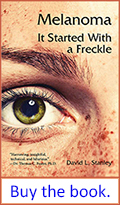
David L. Stanley's masterful telling of his bout with skin cancer Melanoma: It Started with a Freckle is available in print, Kindle eBook and audiobook versions, just click on the Amazon link on the right.
David L. Stanley writes:
Yes, La Vuelta 22 was all that and a bag of frites. With maybe a platter of moules and a mug of Rédor Pils close at hand. At the race’s start, I believed this would be the most open of the season’s three Grand Tours. I was wrong.
La Vuelta 2022 was all-Remco, all the time. We might not have witnessed a coronation, but we did see an unveiling. We saw the full flowering of a resplendent talent that heretofore had shone in one day races. This season, we saw Remco take a brilliant win at Liege to claim his first monument. On July 30th, Remco soloed 45 km to take a dominant victory in the Clasica San Sebastian, yet his abilities over three weeks had not yet been demonstrated. Until the Vuelta a España 22.
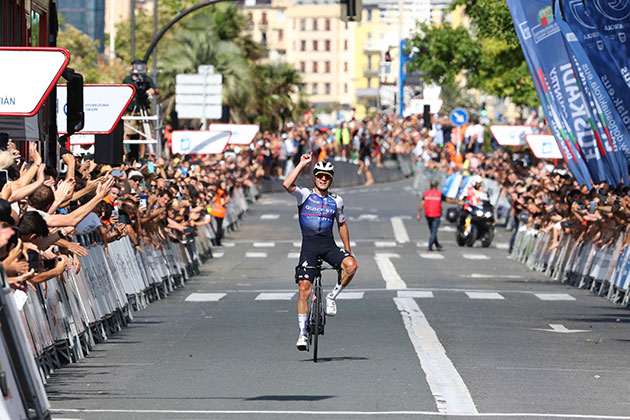
Remco Evenepoel solos to victory at San Sebastian. Sirotti photo
This Vuelta was a showcase for the 5’7”, 132 lb Belgian with a complete set of cycling skills. In the days before the start in Utrecht, I saw 7 men with legitimate shots at the win:
Joâo Almeida (UAE Team Emirates)
Richard Carapaz (Ineos Grenadiers)
Remco Evenepoel (Quick-Step Alpha Vinyl)
Jai Hindley (Bora-Hansgrohe)
Enric Mas (Movistar)
Primoz Roglič (Jumbo-Visma)
Simon Yates (BikeExchange-Jayco)
I was wrong. Remco showed us his climbing skills on Stage 6 from Ascensión al Pico Jano, San Miguel de Aguayo and claimed the leader’s red jersey. He cemented his lead with a decisive win in the Stage 10 Alicante time trial. From then on, Remco’s only opponent until Madrid was the possibility of mishap. A handful of assorted riders attacked; there was serious pressure from Primož Roglič, yet the 22-year-old from Aalst managed the attacks with shows of strength and savvy.
The nationalistic pressure on young Remco was immense. For all its stage racing success in the post-WWII era and its dominance in one-day racing, the last Belgian to win a Grand Tour was Johan de Muynck at the 1978 Giro. The last Belgian to win La Vuelta was Freddy Maertens with his mind-blowing 1977 Vuelta. Fast Freddy won the first and last stages and 11 others in between as well as the points classification. It had been 44 years for a country which regards road cycling as their fiefdom; no pressure there.

Freddy Maertens, the last Belgian to win La Vuelta until Remco Evenepoel.
He's 22 years old, this Remco. The prevailing wisdom throughout cycling’s history is that riders need to work their way into winning Grand Tours, that they need the strength accumulated over riding 3 week races before they went for the win, that the wisdom accrued in service to their leaders was a requirement. That prevailing wisdom is very wrong. Which brings me to this ---
IS IT TIME TO ABOLISH THE YOUNG RIDER JERSEY?
Look at this list.
Joâo Almeida (UAE Team Emirates) - 24
Thyman Arensman (DSM) – 22
Juan Ayuso (UAE Team Emirates) – 19
Remco Evenepoel (Quick-Step Alpha Vinyl) – 22
Ethan Hayter (Ineos Grenadiers) – 23
Tom Pidcock (Ineos Grenadiers) - 23
Tadej Pogacar (UAE Team Emirates) – 23
Carlos Rodriguez (Ineos Grenadiers) - 21
Jonas Vingegaard (Jumbo-Visma) - 25
Fred Wright (Bahrain Victorious) – 23
That is a 10-man massive traffic stopping pile-up on the 405 freeway worth of U-25 talent. We see it in other sports. Men’s tennis has a similarly talented group of U-25 players. The fastest mile run by a man this year was by the Norwegian Olympic champion Jakob Ingebrigtsen. The 21-year old ran the world's fastest mile in 21 years, clocking 3:46.46 at a Diamond League meet in Oslo on 16 June. It’s a hip-hop world—get on board or get out of the way.
Perhaps it is time to eliminate the “Best Young Rider” jersey and institute a “Best Rider Over 30” category instead. Look at the GC following Stage 18. There are two men, and two men only, Joao Goncalves (UAE Team Emirates), age 33, and Rigoberto Uran (EF Education-Easypost), age 35, past age 30 in the top ten. And at 7:14 and 9:56 respectively, they are barely in the same time zone as Numbers 1 & 2: Evenepoel and Enric Mas (Movistar). Who to sponsor the jersey? I’m thinking AARP would want a piece of that action.
CYCLING IS BRUTAL.
49 riders failed to finish the Vuelta in 2022. 23 returned covid positives with viral loads sufficient to remove them from the race. That leaves 26 riders out with fatigue, crashes, and other forms of illness. (Stats-Friday, 9/9/22.) Julian Alaphilippe crashed out in Stage 11. At that time, he had raced to mentor young Remco and it was thought his absence might impact Remco’s chances to keep the jersey. That thought was wrong.
Jay Vine rode with panache on his way to a stint in the climber’s jersey and the strong likelihood that he would wear the jersey in Madrid until a particularly nasty crash at the start of Stage 18 to Alto de Piorna eliminated him from the race.
Israel-PremierTech’s Rusty Woods crashed out with a concussion during Stage 3.
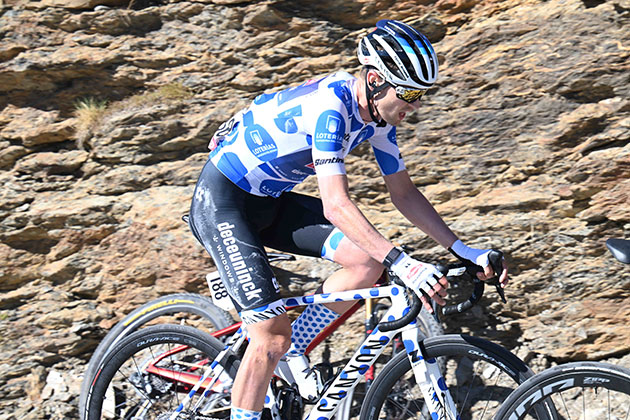
It looked like Jay Vine would be the 2022 Vuelta King of the Mountains. Sirotti photo
Most notably, Primož Roglič (Jumbo-Visma) left the race after he crashed on Stage 16. The 137-pound Roglic swung wide in the closing few hundred meters, and without warning, decided to ride down on Fred Wright who, nearly against the barricades, held his line. The 165 pound Mr. Wright stayed up. Primoz went down very hard, at speed, and although he finished the stage, you could see he was stunned and disoriented. On Friday, 09 September, Jumbo-Visma, their DS Richard Plugge, and Roglic all issued vicious and inaccurate screeds against Fred Wright that blamed him in total for Roglic’s crash and subsequent withdrawal from the race. Jumbo-Visma was very wrong.
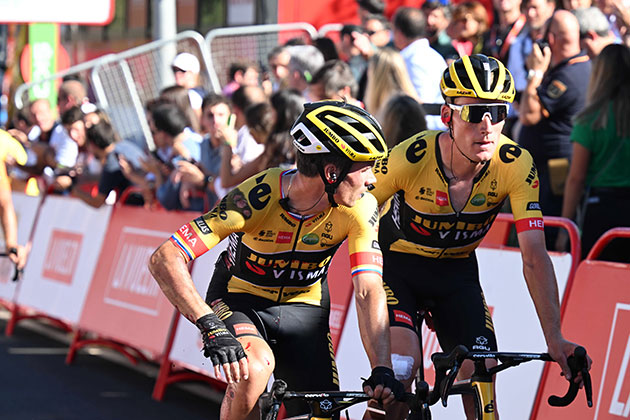
Roglic just after his crash. Sirotti photo
I do feel for Roglic. This is a brutal sport. Tarmac is unforgiving. Lycra offers no protection against impact. It takes only 20-25 lbs of pressure to shatter a collarbone. The bicycle itself is easily upset. The contact patch of a road cycling tire is about 1 square inch. The riders, then, are each supported by about a matchbook’s worth of friction between their rubber and the road. It does not take much to upset a rider’s tenuous equilibrium. It is also a truism that “so-and-so crashes a lot.”
Fans frequently say, “Ah, Froome, he’s always crashing” or “No one crashes as much as Roglic” yet we have nothing except limited TV coverage to back up those claims. Of course, it appears they crash a lot. They’re the guys that the TV cameras are always focused upon. I’d like to see a crash databank. I’ve searched the internet and can find no credible data banks. If anyone knows of one, get with me @DStan58 on Twitter.
It does seems that “There are certainly a lot more crashes this year” is a Grand Tour mantra. Crash damage is cumulative. You crash several times in a stage race, each one beats you down exponentially and leaves you more vulnerable to another incident. Even one crash can be plenty destructive when you land wrong. The fatigue, mental and physical, is brutal, and riders make mistakes they would not normally make. Like Primoz Roglic did on Stage 16.
Hitting tarmac at speed is like being beaten with a baseball bat coated in 60 grit sandpaper. As Jonathon Vaughters famously said, “Get in a car going 30 mph. Strip down to your underwear. Jump out.”
IS MID-SEASON THE TIME TO ANNOUNCE NEXT YEAR’S NEW SIGNINGS?
I cohost a podcast, the Feed Zone, which is part of the Cycling Legends audio magazine and we debated this last week. Why is cycling the only sport which announces signings for new teams in the middle of the season? As far as I can tell, these mid-season announcements of next year’s squads occur only in cycling. Not MLB, NFL, NHL, MLS, or EPL. Players do move from team to team in mid-season, yet they play for the new team immediately.
By now, we all now that Richard Carapaz of Ineos will race for EF-EasyPost next year. The move was announced just days before the start of the Vuelta. I understand EF’s motivation; if Carapaz has a good Vuelta, that offers EF a fair share of free, reflected glory, and a leg up for next season’s marketing. I would hope that Carapaz and his teammates, old and new, are professional enough that they continued to ride appropriately. (Note: I’m not accusing Carapaz of one single thing. His case is just a convenient example.)
Sadly, while I’d like to think that “riding for the new team in old team’s kit” is a rare occurrence, I am also cycle-worn enough to think that for some athletes, perhaps those without a Grand Tour win in their palmares, the opportunity do some quiet work for the new team might give them the leg up, and perhaps some quiet cash, as they seek their place in the new squad’s pecking order. We have certainly seen our share of Nation vs. Pro Team division at cycling’s world championships.
Some might argue that if mid-season signings are banned, then riders lose negotiating power given cycling’s short off-season. Perhaps cycling needs to institute transfer fees to protect the riders. If EF-EasyPost wants Carapaz, should they pay Ineos a percent of Carapaz’s salary, with a sizeable portion going to Carapaz? Pro cycling needs more transparency, not less.
LET’S TALK CARAPAZ.
What happened to Richard in the first week? He lost nearly 5:00 by stage 6, and then won three stages: 12, 14, & 20. And he still finished 28:00 minutes behind on GC. Carapaz ended the 3 weeks with the strength and panache of a Grand Tour winner (Giro, 2019) who is frequently seen on the podiums of the toughest races.

Richard Carapaz wins stage 20. Sirotti photo
LET’S TALK THYMEN ARENSON.
He’s Dutch. He’s 22. He rides for DSM. An incredible climber. Did you know of him before this race? Me, neither. I suspect we will become more familiar with his particular idiom.
LET’S TALK MADS PETERSON.
Stage 13, 16,19 – winner. He might not be the World’s Fastest Man, but he is certainly the fastest man after 200 hilly and challenging kilometers. With the Worlds on Sept 25, on a punchy course, he must also be a favorite (if he does indeed make the trek to Wollongong) to take another rainbow jersey to go with his from 2019 in Yorkshire, home of the World’s Best Tea, England.
LET’S TALK ENRIC MAS.
You cannot give away 1:51 in 30 km TT to a guy who can climb as well as Remco. But if not for Remco’s otherworldly explosion, Enric Mas might well have won his first GT. At 27, according to traditional wisdom, he’s coming into his own. Traditional wisdom, perhaps in this case, might be right.
LET’S TALK JUAN AYUSO.
Juan turns 20 on September 16. He finished 4:57 behind Remco and 2:55 behind Enric Mas. He is four years younger than the other UAE TEAM Emirates wunderkind Tadej Pogačar. Things could get very interesting at the team meetings in the early spring as they sort out who rides for who in what races.
LET’S TALK FRED WRIGHT & LAWSON CRADDOCK.
Lawson and Fred were two of the most aggressive riders in this year’s race. No mountain too high, no valley too broad for these two men to go on the attack. They both showed terrific brio and self-assurance as they threw themselves into the attack on nearly every stage. Chapeau to the pair for making a lively race truly even more exuberant.
LET’S TALK HERO.
With every Grand Tour, I name a hero. This year’s hero is the Linterna Roja, Davide Cimolai (Cofidis). He raced the same 3283 km as Remco Evenepoel. He suffered as much, perhaps more, over the course of the race. Remco covered the distance in 80 hrs, 26 minutes, and 59 seconds. Davide struggled to his last place, 134th place finish, 5 hours, 31 minutes, and 26 seconds behind the winner. 181 riders started the race. On average, he trailed in 15 minutes behind Remco. Yet, Davide finished ahead of the 47 men who did not make it to Madrid; men who were strong enough to be named to their team’s starting squads. Every day, Cimolai did the work for the team, made it to the finish within the time limit, and the next day, he got on the bike to do it again. No glory, but lots of guts.
LET’S TALK REMCO.
Stage 10 – Remco wins a 31 km time trial by 00:48 over his nearest competitor, Roglic. He rides the full distance at an average speed of 55.8 KPH, that’s 34.67 MPH. Remco used a 60 tooth chainring on the front for his effort. A 60 tooth chainring is about 9.85 inches in diameter. The diameter of a standard glass pie tin is 10 inches. If Remco rode in the 60x13 at 100 RPM for most of the race, that’s 36 MPH. In other words, each pedal revolution carried him 9.8 meters.
Massive, indeed, and he crushed all comers.
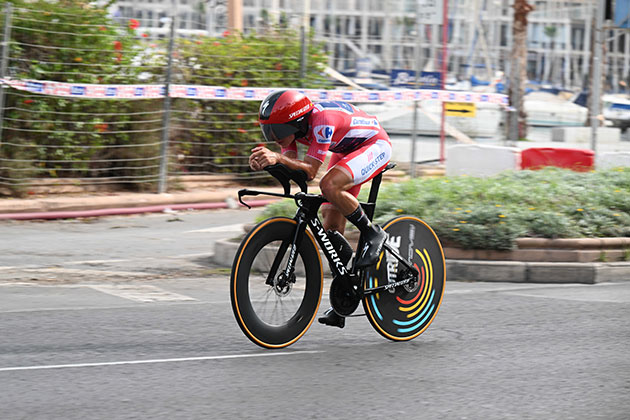
Flat-backed, fast-moving Remco Evenepoel riding the stage 10 time trial. Sirotti photo
Stage 14 - The telling moment of the Vuelta was Stage 14 to Sierra de La Pandera. Evenepoel was dropped but he did not panic. He calmly rode the climb on his own terms and limited his loss to Roglic to less than 50 seconds. Don’t you think most 22 year olds would have panicked and blown up? By keeping his cool, Remco kept a tight grip on the camiseta roja.
Stage 18 – Remco wins a summit finish sprint over two of the finest pure climbers in the game, Enric Mas and Robert Gesink (Jumbo-Visma). He looked at them and said, “Not today, my friends. Pas de cadeaux, neen cadeaus” as he sprinted to take a classic mountain top finish on the 192 km stage from Trujillo to Alto de Piornal.
The G.C. Breakdown – Remco took the red jersey on Stage 6 by 21 seconds over Rudy Molard. On Stage 8, his lead went out to 28 seconds over Enric Mas. Stage 9, out to 1:12 over Mas. At Stage 10, the time trial, Remco led Roglic by 2:41. On Stage 14, Roglic clawed himself back to within 1:49 and to within 1:34 on Stage 15. Roglic would edge even closer after Stage 16 at 1:26. Yet, his noteworthy crash would knock him out of the race, and move Enric Mas into second at 2:01. Stage 18, Remco took his lead out to 2:07. He would take the win with a gap of 2:02 over Mas.

Evenepoel after stage 21. Sirotti photo.
Remco won in the time trial. He won in the mountains. He stayed at the front on the lumpy stages designed for the puncheurs, and he stayed out of trouble on the flats. He raced with power, he raced with smarts, and he raced with confidence. He is a Grand Tour winner with estilo. The big question—do we see him continue to race with a focus on Grand Tours, or does he shape his career around the formidable challenges of classic one day races? Perhaps, as we’ve seen with several other current champs, he’ll pick and choose a few one day races and aim to take the Giro and Tour along the way?
With Remco and Tadej and Jonas and Wout van Aert and Jai and a dozen other exceptionally strong young riders, we are at the dawn of another Golden Age of cycling and I am here for it.
David Stanley, like nearly all of us, has spent his life working and playing outdoors. He got a case of Melanoma as a result. Here's his telling of his beating that disease. And when you go out, please put on sunscreen.







